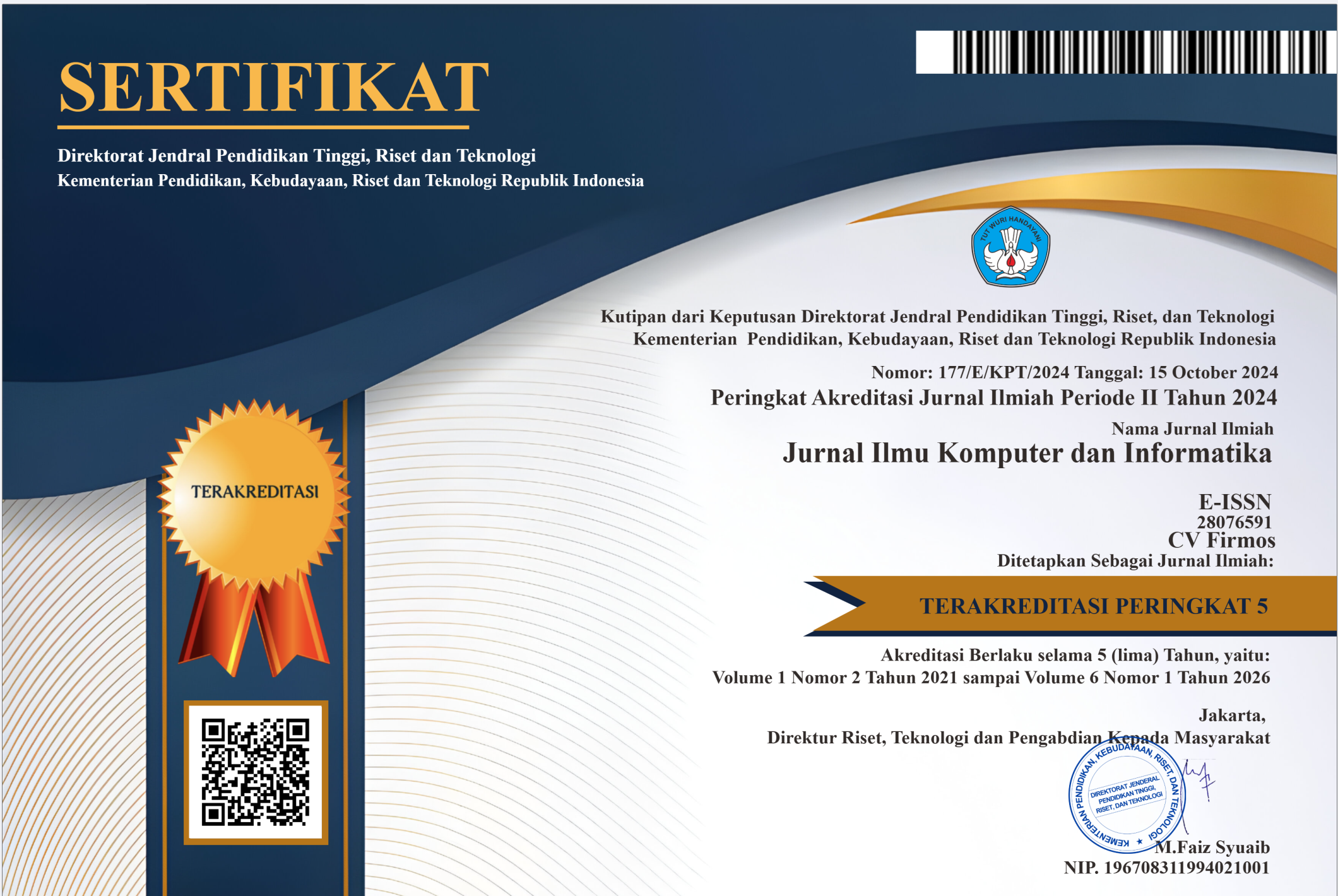Analisis Prediksi Stroke dengan Membandingkan Tiga Metode Klasifikasi Decision Tree, Naïve Bayes, dan Random Forest
DOI:
https://doi.org/10.54082/jiki.90Keywords:
Decision Tree, Klasifikasi, Naïve Bayes, Prediksi Stroke, Random ForestAbstract
Prediksi stroke telah muncul sebagai bidang penelitian dan intervensi kesehatan yang penting karena dampaknya yang signifikan terhadap kesehatan masyarakat dan kesejahteraan individu. Pemeriksaan rinci mengenai usia, hipertensi, penyakit jantung, status perkawinan, jenis pekerjaan, jenis tempat tinggal, rata-rata kadar glukosa, BMI, status merokok, dan jenis kelamin sebagai factor terjadinya stroke. Dengan melakukan sintesis penelitian dan menganalisis kumpulan data yang luas, penelitian ini bertujuan untuk menjelaskan hubungan rumit antara faktor-faktor tersebut dan dampak kumulatifnya terhadap risiko stroke. Metode penelitian ini diawali dengan perbandingan algoritma Decision Tree, Naïve Bayes dan Random Forest dengan menggunakan software RapidMiner. Dari dataset prediksi stroke yang diberikan, terdapat 5110 responden dengan kondisi beragam. Di antara 5110 responden tersebut terdapat 12 atribut. Berdasarkan uraian yang telah dibahas maka dapat diambil kesimpulan bahwa metode Decision Tree merupakan metode terbaik dengan nilai akurasi tertinggi sebesar 95,13% dibandingkan dengan metode Random Forest dan Naïve Bayes dan nilai TF (True False) yang dipilih adalah 4861, TT (True True) adalah 0, FF (False False) adalah 249, dan FT (False True) adalah 0.
References
J. Li, Y. Luo, M. Dong, Y. Liang, X. Zhao, Y. Zhang and Z. Ge, "Tree-Based Risk Factor Identification and Stroke Level Prediction in Stroke Cohort Study," Biomed Research International, pp. 1-10, 2023.
R. D. Nindrea and A. Hasanuddin, "Non-modifiable and modifiable factors contributing to recurrent stroke: A systematic review and meta-analysis," Clinical Epidemiology and Global Health , p. 101240, 2023.
F. D. Fuchs and P. K. Whelton, "High Blood Pressure and Cardiovascular Disease," Hypertension, vol. 75, no. 2, pp. 285-292, 2020.
D. Puciato, M. Rozpara, M. Bugdol and B. Mróz-Gorgoń , "Socio-economic correlates of quality of life in single and married urban individuals: a Polish case study," Health Qual Life Outcomes, vol. 20, no. 58, 2022.
M. Bakhtiyari, E. Kazemian, K. Kabir, F. Hadaegh, S. Aghajanian, P. Mardi, N. T. Ghahfarokhi, A. Ghanbari, M. A. Mansournia and F. Azizi, "Contribution of obesity and cardiometabolic risk factors in developing cardiovascular disease: a population-based cohort study," Scientific Reports, vol. 12, 2022.
J. Chen, S. Li, K. Zheng, H. Wang, Y. Xie, P. Xu, Z. Dai, M. Gu, Y. Xia, M. Zhao, X. Liu and G. Xu, "Impact of Smoking Status on Stroke Recurrence," Journal of the American Heart Association, 2019.
C. W. Yoon and C. D. Bushnell, "Stroke in Women: A Review Focused on Epidemiology, Risk Factors, and Outcomes," Journal of Stroke, vol. 25, no. 1, pp. 2-15, 2023.
R. Huang, J. Liu, T. K. Wan, D. Siriwanna, Y. M. P. Woo, A. Vodencarevic, C. W. Wong and K. H. K. Chan, "Stroke mortality prediction based on ensemble learning and the combination of structured and textual data," Computers in Biology and Medicine, p. 106176, 2023.
P. Kunwar and P. Choudhary, "A stacked ensemble model for automatic stroke prediction using only raw electrocardiogram," Intelligent Systems with Applications, p. 200165, 2023.
L. I. Santos, M. O. Camargos, M. F. S. V. D’Angelo, J. B. Mendes, E. E. C. d. Medeiros, A. L. S. Guimarães and R. M. Palhares, "Decision tree and artificial immune systems for stroke prediction in imbalanced data," Expert Systems with Applications, vol. 191, 2022.
N. Biswas, K. M. M. Uddin, S. T. Rikta and S. K. Dey, "A comparative analysis of machine learning classifiers for stroke prediction: A predictive analytics approach," Healthcare Analytics, vol. 2, 2022.
B. T. Jijo and A. M. Abdulazeez, "Classification Based on Decision Tree Algorithm for Machine Learning," Journal of Applied Science and Technology Trends, pp. 20-28, 2021.
V. Matzavela and E. Alepis, "Decision tree learning through a Predictive Model for Student Academic Performance in Intelligent M-Learning environments," Computers and Education: Artificial Intelligence, p. 100035, 2021
I. Wickramasinghe and H. Kalutarage, "Naive Bayes: applications, variations and vulnerabilities: a review of literature with code snippets for implementation," Soft Computing, 2020.
V. Sheth, U. Tripathi and A. Sharma, "A Comparative Analysis of Machine Learning Algorithms for Classification Purpose," Procedia Computer Science 215, p. 422–431, 2022.
M. Schonlau and R. Y. Zou, "The random forest algorithm for statistical learning," The Stata Journal, pp. 3-29, 2020.
. H. Patel and P. Prajapati, "Study and Analysis of Decision Tree Based Classification Algorithms," International Journal of Computer Sciences and Engineering, pp. 74-78, 2018.
Downloads
Published
How to Cite
Issue
Section
License
Copyright (c) 2024 Yunita Aulia, Andriyansyah Andriyansyah, Suharjito Suharjito, Sri Wahyu Nensi

This work is licensed under a Creative Commons Attribution 4.0 International License.


















